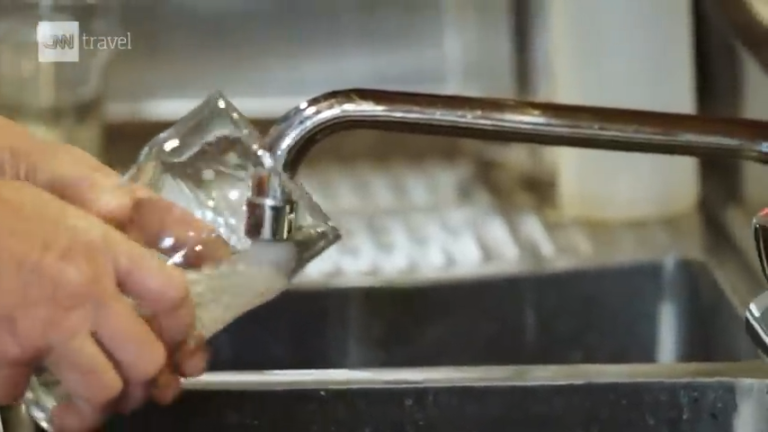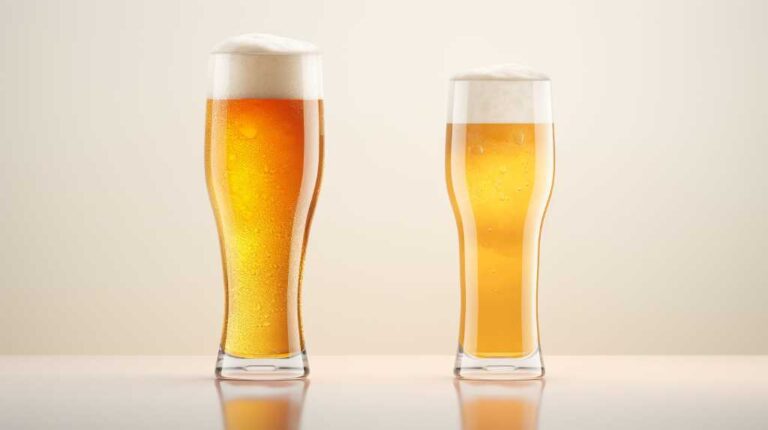How Many Beers Are in a Case? (Charts)

Are you curious about how many beers are in a case? Look no further! In this article, we will provide you with all the information you need to satisfy your curiosity.
We’ll discuss the different sizes of beer cases, popular brands and their packaging, and even delve into beer consumption trends and production methods.
So, grab a cold beer and join us on this informative journey through the world of beer packaging.
Cheers!
Standard Beer Case Sizes
How many beers are usually in a standard beer case?
The average beer case can hold 24 cans or bottles. However, different brands may have cases with 12 or 30 cans/bottles. It’s worth noting that these variations aren’t as common as the standard 24-beer case.
Beer cases are typically made of cardboard or plastic and are designed to protect the bottles or cans during transportation. While the size and shape of beer cases can vary, the average capacity remains at 24 beers.
Popular Beer Brands and Packaging
When it comes to popular beer brands and their packaging options, there’s a wide range of choices available. Let’s explore some well-known beer brands and their packaging trends:
- Budweiser: Budweiser, a globally recognized brand, offers its beer in cans and bottles. It’s commonly packaged in cases of 24.
- Heineken: Another popular brand, Heineken, is known for its beer in green bottles. It’s often sold in cases of 24.
- Corona: Corona stands out with its clear bottles and is typically packaged in cases of 24 or packs of 12.
- Coors: Coors provides its beer in cans and bottles, usually sold in cases of 24 or packs of 12.
- Craft Beer Brands: Craft beer brands such as Sierra Nevada and Dogfish Head have gained popularity. They often feature unique designs and are available in smaller quantities.
These beer packaging trends reflect the preferences and occasions of beer consumers worldwide. Whether you prefer a classic brand like Budweiser or enjoy exploring craft beer options, there’s a packaging choice that suits everyone’s taste.
Beer Consumption Trends and Statistics
Understanding current beer consumption trends and statistics involves analyzing quantifiable data on global and regional beer consumption. The amount of beer people consume varies greatly from country to country, with some nations having higher per capita consumption rates than others. Cultural norms, social habits, and economic factors all play a role in influencing beer consumption. For instance, countries like Germany, the Czech Republic, and Austria are known for their high levels of beer consumption.
It’s important to recognize that beer consumption isn’t a static trend, but rather a dynamic and evolving one. Various factors, such as changing demographics, health consciousness, and the availability of alternative beverage options, contribute to the shifting landscape of beer consumption.
Adapting to these changing consumer preferences is crucial for breweries and policymakers alike, as it allows them to develop effective marketing strategies and remain competitive in the market.
Beer Production and Brewing Methods
Understanding the scale of beer production and the different methods used in brewing can deepen your appreciation for the beer you enjoy. Here are some key points to consider:
- Beer production methods: Large-scale breweries use automated systems for efficient and consistent beer production. Craft breweries, on the other hand, focus on small-batch production and experimentation, which allows for the creation of unique flavors and styles.
- Types of beer packaging: Cases, typically made of cardboard or plastic, are designed to protect bottles or cans during transportation. A standard beer case contains 24 cans or bottles, although some brands may offer 12 or 30. Beer packs come in various sizes, such as 6, 4, 8, and 12 cans or bottles. For larger groups or parties, beer racks, which can hold 30 or two dozen 12 oz beers, are often used.
Understanding the production methods and packaging options can enhance your beer drinking experience and help you navigate the diverse world of beer.
Understanding Beer Cases, Packs, and Racks
Understanding Beer Cases, Packs, and Racks
Beer cases, packs, and racks are important for safely transporting and storing your favorite brews. When it comes to beer cases, there are different options available, such as cardboard and plastic cases.
Cardboard cases are commonly used and provide a lightweight and cost-effective solution for carrying your beer. On the other hand, plastic cases offer durability and are more resistant to moisture and impact. The choice between cardboard and plastic cases may depend on personal preference and the intended use of the case.
It’s also worth considering cultural influences on beer consumption patterns. For example, in countries like Germany, Czech Republic, and Austria, beer consumption tends to be higher due to cultural traditions and social norms surrounding beer.
Differentiating Beer Packs and Cases
Understanding the difference between beer packs and cases involves knowing how they’re packaged and the quantities they contain. Here are some key points to help you differentiate between the two:
- Beer pack sizes: Beer packs come in various sizes, such as 6, 4, 8, and 12 12 oz beers. These packs are commonly used for smaller gatherings or personal consumption.
- Common misconceptions about beer cases: One misconception is that all cases contain 24 beers. While 24 is the most common number, some cases may have 12 or 30 cans/bottles, depending on the brand. To know the exact quantity, it’s important to check the label or description.
- Packaging materials: Cases are typically made of cardboard or plastic and are designed to protect the bottles or cans during transportation.
- Size and shape: Beer cases can vary in size and shape, but they’re generally smaller and more compact compared to beer racks.
- Purpose: Beer cases are usually used for individual or small group consumption, while beer racks are often preferred for parties or larger gatherings.
Comparing Beer Cases With Kegs and Beer Balls
Comparing beer cases with kegs and beer balls involves understanding their respective volumes and packaging materials. To better understand the differences, let’s compare them using a table:
| Packaging | Volume | Number of Beers | Cost per Ounce | Environmental Impact |
|---|---|---|---|---|
| Beer Cases | 2.25 gallons | 24 | Calculated based on price per case | Depends on packaging material |
| Beer Kegs | Varies | Varies | Calculated based on price per keg | Requires returnable/refillable kegs |
| Beer Balls | 5 gallons | Approximately 2 cases | Calculated based on price per ball | Requires returnable/refillable balls |
When calculating the cost per ounce, it’s important to consider the price per packaging size. The environmental impact of each option also varies, with beer cases and beer balls requiring returnable/refillable packaging, while beer kegs offer the most sustainable option. Understanding these factors can help you make an informed decision based on your needs and preferences.
Frequently Asked Questions
What Are Some Environmentally Sustainable Practices in the Brewing Industry?
Environmentally friendly brewing practices in the beer industry involve the use of renewable energy sources, water conservation techniques, and the reduction of carbon emissions. Additionally, sustainable packaging options such as biodegradable materials and lightweight containers are employed to minimize the industry’s environmental impact. These practices are crucial for the brewing industry to contribute to a more sustainable future and protect our planet for generations to come.
What Is the Difference Between Lager and Ale?
Lagers and ales have distinct taste differences because of variations in the brewing process. Lagers have a crisp and light flavor profile, while ales are more robust and fruity in taste. Understanding these variations can help you appreciate the nuances of different beers and connect with fellow beer enthusiasts.
How Do Craft Breweries Differ From Large-Scale Breweries in Terms of Beer Production?
Craft breweries differ from large-scale breweries in terms of beer production by utilizing unique techniques and focusing on small-scale operations. Unlike larger breweries, craft breweries prioritize experimentation and the creation of distinct flavors and styles. This emphasis on creativity and variety allows craft breweries to contribute to the diverse landscape of the beer industry. By championing innovation and small-batch production, craft breweries offer consumers a refreshing alternative to mass-produced beers. As a result, beer enthusiasts can enjoy a wide range of flavors and support local businesses at the same time. Craft breweries truly embody the spirit of artisanal craftsmanship and continue to shape the ever-evolving world of beer production.
What Are Some Examples of Unique Beer Brands Produced by Local Breweries?
Local breweries contribute to the beer market by producing distinctive and diverse beer brands. These breweries prioritize sustainability and experimentation, offering consumers a refreshing change from the mass-produced offerings of large-scale breweries. The consumption of beer varies across different regions and countries, with lager and ale being the most popular types. Local breweries play a crucial role in adding flavor and variety to the beer industry, catering to the unique tastes and preferences of beer enthusiasts.
How Does Beer Consumption Vary Across Different Regions and Countries?
Beer consumption varies significantly across different regions and countries. This variation is influenced by cultural and social norms, availability, and individual preferences. Understanding these regional differences in beer consumption is important for market analysis and targeting specific demographics. By examining the factors that contribute to these variations, businesses can effectively tailor their strategies to meet the needs and preferences of different regions. Additionally, analyzing beer consumption patterns can provide insights into the cultural significance of beer in different parts of the world. This knowledge can help businesses develop targeted marketing campaigns and product offerings that resonate with consumers in each specific region.






